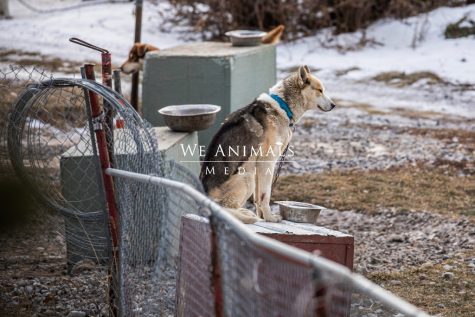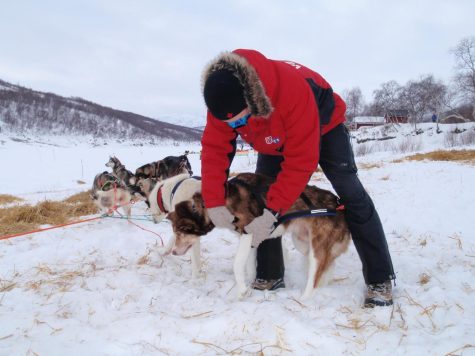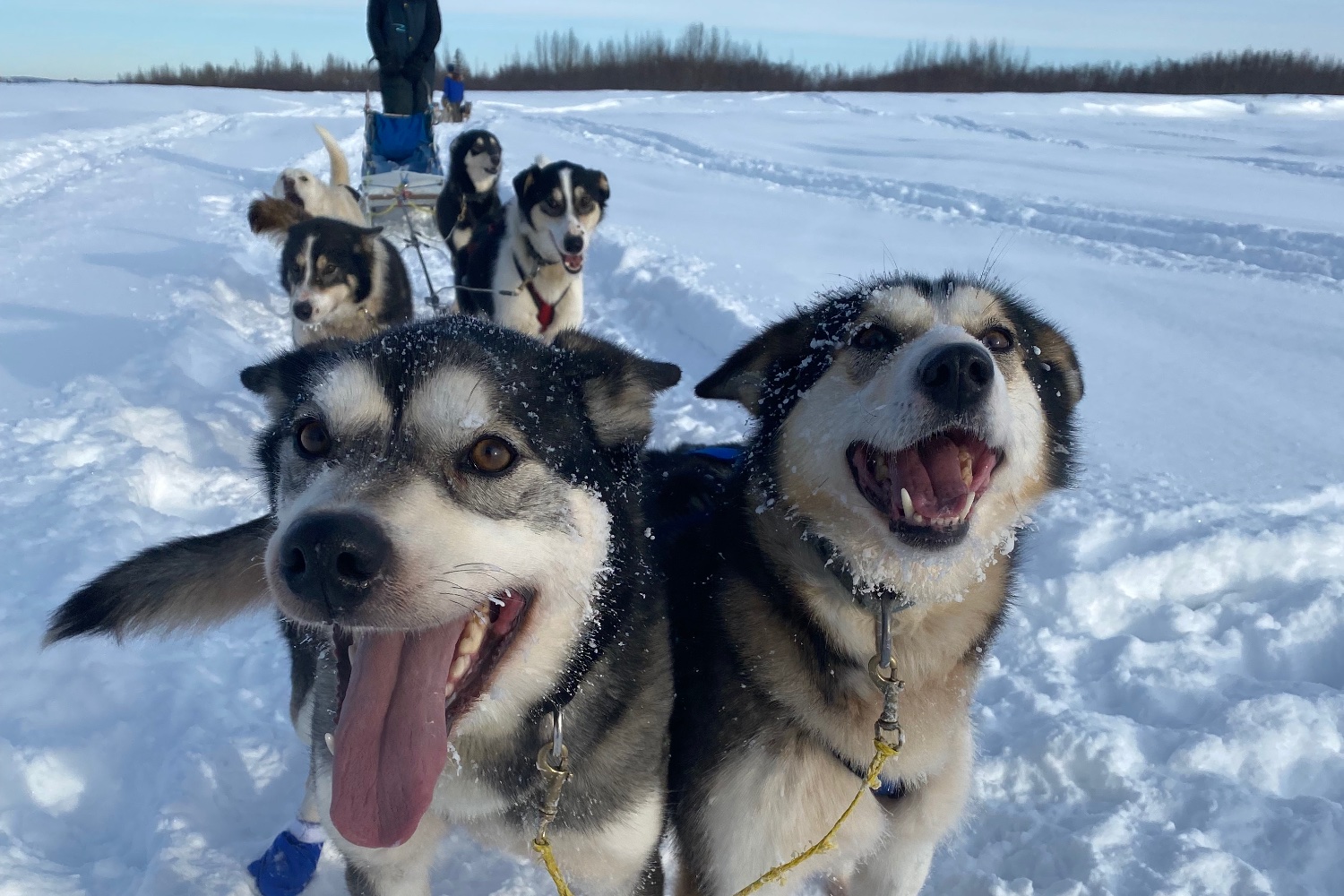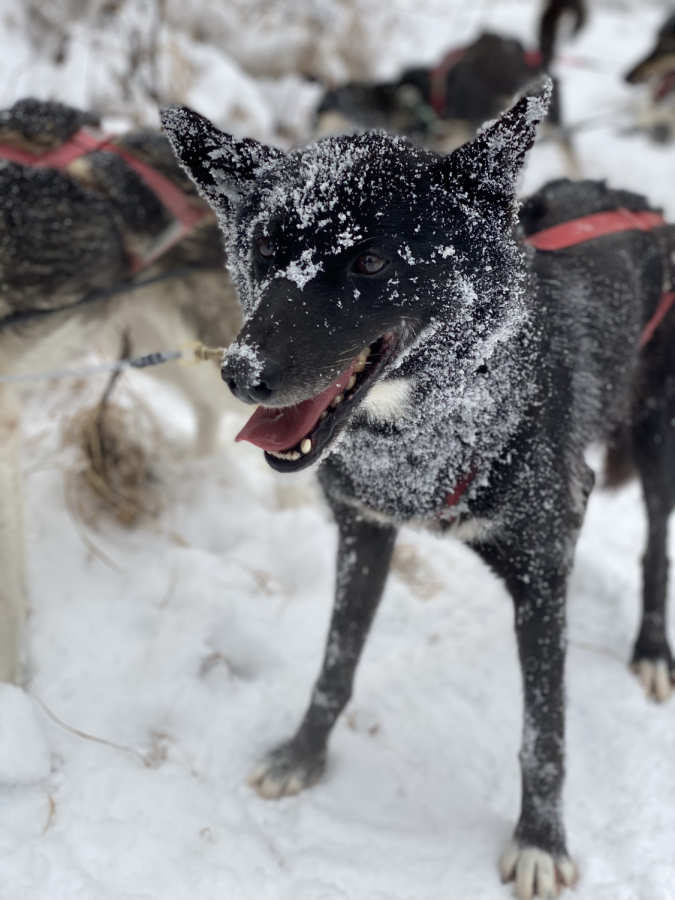
The fine line between treatment of sled dogs and pet dogs
Thousands of sled dogs live between two sides of controversial kennel life
December 19, 2022
Lit by a headlamp in the dark Alaskan night, two dogs named Jonesy and Bowie wag their tails at the sight of Katrina Handler, a dog handler at the Trail Breaker Kennel. Both dogs jump on their snow covered, straw filled houses. Proof of mistreatment toward sled dogs exists, but caring communities of sled dog teams also exist. There is an undeniable bond between Handler and her team of dogs.
The Trail Breaker Kennel, located in Alaska, was founded by Susan Butcher, a multi Iditarod champion. Handler has been a dog handler at this kennel for five years, but she has worked with sled dogs for six years.
“When you’re out there with 14 of your best friends for 100 miles and 24 hours, it’s hard not to bond with them. I’ve had my team save my life before,” Handler said.
A pet dog runs through life with their human. They run along beaches at sunset and up hills at sunrise with their tails wagging and tongues hanging out.
They are naturally active animals, but like any other living being, they get tired and need quality food and rest to be able to live their best life.
A sled dog, one of the most active dogs in the world, is born to run, not to suffer.
Sled dogs can burn up to 12,000 calories a day, using their high metabolism more than their fur to keep warm. Their ideal temperature is near negative 20 degrees Fahrenheit.
In the blizzardous winter of 1925, teams of sled dogs and their mushers who steered the sled, put their speed to the test to deliver lifesaving medicine to the city of Nome, Alaska when help from automobiles was cut off by the storm.
Their 674 mile journey became known as the Serum Run, preventing an epidemic of diphtheria, a respiratory infection.
This memorable race against the clock is commemorated every year with the Iditarod race. Commemoration has turned into competition where mushers and their teams of dogs take on the 1,049 mile race from Anchorage to Nome.
A vast number of kennels around the world house sled dogs for competitions like the Iditarod. What is it like for a dog in a kennel?
According to drone footage taken by activist Frank Metivier in Quebec Canada, some kennels are inhumane with flimsy boxes for shelter, short tethers, and no freedom. Aerial footage and multiple videos of a kennel in Whistler showed sled dogs confined to a tiny space, pacing back and forth and around in circles for endless hours. Their tails hang between their back legs and their eyes have no light of excitement in them. The dogs display signs seen in animals in captivity. A chained dog has no choice but to urinate and sleep in the same place, going against their natural instinct.

Organizations like the Vancouver Humane Society (VHS) are fighting to abolish inhumane sled dog treatment. Their belief is that all animals including sled dogs should not be exploited for human use and entertainment.
The VHS works against suffering in the sled dog industry through policy advocacy mainly in British Columbia. The Canadian Veterinary Medical Association’s kennel code includes guidelines about housing, food and water, health management, breeding, transport, and end of life considerations including euthanasia.
“We are advocating for regulations around sled dogs to be updated to conform to standards already acknowledged in the kennel code which would help to address the issues of prolonged tethering and euthanasia by gunshot,” Chantelle Archambault, communications director of VHS, said.
Section one of the kennel code requires restraining devices used for tethering to allow the dog to move in a safe manner. In a letter to the Honourable Lana Popham, Minister of Agriculture, VHS expressed their concern about tethers.
“We believe there is considerable public concern about the conditions dogs are currently kept in by sled dog tour operators in the province. These conditions include tethering dogs for more than 23 hours a day,” Amy Morris, executive director of VHS, wrote in 2021.
A sled dog tethered to their house, looks different than pet dogs who are normally indoors.
“I would urge the people who are against it to take the time to learn about the breed…when people ask me why they’re chained up, I say there are several reasons. First of all, they can socialize with each other but still have their own personal space,” Handler said.
Handler admits to there being one in every crowd that isn’t respected within the community because of the way they mistreat their dogs.
“When it comes to dog mushing, there’s so much work, so you need to help each other out. And if somebody isn’t being nice to their dogs, nobody wants to help them. Then they don’t like running because it’s too much work for one person. They can’t have fun on the trail because everyone is trying to avoid them, and they can’t have fun in races because nobody wants to help them out,” Handler said.
Training
The care Trail Breaker Kennel puts into their dogs includes training which prepares the dogs for a race and helps prevent injuries.
“The only reason a dog would get over-exhausted is if the person didn’t train them,” Handler said.
During training runs, Handler switches up the teams and positions of the dogs, so they don’t get bored.
“We don’t want every dog working with the same dog in the same position every single run because that’s like us working with the same person for 40 years,” Handler said.
She takes into account the harmony of the sled dog’s mental and physical health.
“If you have a really healthy dog, but they’re not happy, they’re not going to want to run or pull. If you have a really happy dog that is super overweight and super unhealthy, then they can’t run because they’ll give themselves a heart attack,” Handler said.
The Trail Breaker Kennel is located near a river and lake making a perfect playground for dogs during their time away from pulling sleds.
“We do a lot of off leash walks and playtime, so they can hang out and have fun. During the summer, it’s a lot of swimming,” Handler said.
While someone’s golden retriever might love playing fetch, Handler’s Alaskan huskies love pulling. To train sled dogs pulling for the first time, Handler uses their natural instincts to her advantage.
“When we first put on the harness, they usually flip around and smell it just to check it out and see what it is. A lot of times we just go for a walk with them not pulling anything just so that they get used to the feeling of the harness,” Handler said.
After that, the process is quick.
“I would say it takes about 15 feet before they’re just like ‘oh my god we’re pulling!’…they could be wearing tutus and sunglasses…and they start pulling and not caring about the harness,” Handler said.
A newbie sled dog will run for half a mile to get used to it.
“And by the third time they’ve been in a harness, they get so excited they can’t even stay still for us to get the harness on because they know they get to pull and have fun,” Handler said.
The training differs from season to season. The mileage increases in increments from two miles a day, to five, then eight, then slowly climbs to up to 120 miles a day, as mid and long distance races approach in the early months of the year.
“At that point, we’re going to be going anywhere between 80 to 120 miles a day,” Handler said.
These races that span from 150 to 700 miles are needed to qualify for longer races like the Iditarod.
The sheer number of miles calls for proper awareness of a dog’s condition.
Along trails, Handler brings a vet kit in case a dog gets injured. She also brings a “doggy burrito bag” which is a bag that restrains the movement of an injured dog, so they can rest.
“They hang out in our sled until we get to a place with a vet, or if it’s a training run, once we get back, we can evaluate if it’s a pulled muscle or if a moose punched a hole in the trail, and they stepped in it wrong and rolled their ankle. We can evaluate if they need to see a vet right away,” Handler said.
Treatment of Sled Dogs Raises Ethical Questions
Along races like the Iditarod, checkpoints are set up along the trail where dogs can eat, rest, and get checked out by veterinarians. Here, injuries like pulled muscles are worked out. Dogs in really poor condition are dropped after a veterinarian deems them unable to finish the race.
“It’s common to retire dogs in the race. Generally you explain the situation to the musher and give the option to voluntarily leave the dogs behind at a checkpoint to be cared for. None of the mushers want their dogs to be injured,” Dr. Richard Long, DVM, said.
Long, a veterinarian since 1986, got hooked into volunteering at sled dog races starting with one in Whitehorse Yukon. He loved the beautiful mountains and interacting with mushers.
The decision to let a dog keep racing or to retire them comes from their state of mind and body.
“The basics are the same as I do in my clinic: heart rate, respiration, listening to their lungs, palpate their abdomen, check their legs and feet, check their eyes, ears, nose. I check the whole dog from tip of the nose to tip of the tail,” Long said.

Sled dog races have mandatory checkpoints and race marshals who act as officials of the race organization. A musher may not continue racing until the veterinarians are done with their work.
“Officials in conjunction with a veterinarian have complete control to remove an individual dog or whole team from the race if necessary…I have the power to hold the dog until I’m ready to let it go,” Long said.
A dog is deemed fit enough to keep running after the vet’s prognosis about whether the injury could get better or worse.
“They’re usually allowed to continue…if they’re eating and drinking, getting hydrated, and don’t have a fever,” Long said.
Each dog has a veterinary record carried throughout the whole race, and concerns about their health are jotted in there. According to Long, a common thing during races is diarrhea which is caused by stress or change in diet. If a dog is prescribed treatment for diarrhea or another injury like a sore foot, a vet at the next checkpoint follows up with the musher.
“The mushers are very competitive, however they have a real tender spot for their dogs, so it was a nice combination,” Long said.
Kennel Life
Between the perspectives of the Trail Breaker Kennel and VHS, there are thousands of sled dogs who deserve the best life and thousands who don’t get that.
A veterinarian’s job pertains to kennel visits as well as race checkpoints. Kennels have to give their dogs the standard care stated in the laws for sled dog and mushing facilities. Veterinarians do kennel visits where they examine the dogs and discuss nutrition, deworming programs, and health.
“All the kennels that we examine have to be run to sled dog veterinary care standards, and if they’re not, we work with the mushers to try and improve their conditions…We all have an obligation to make sure the dogs are treated humanely and if they’re not, we report them to the appropriate authorities,” Long said.
Section six of the kennel code states that euthanasia is used if a dog has a determined illness or injury that cannot be reversed to the point where the dog will be able to live a good life. Euthanasia is performed by a veterinarian or under veterinary supervision with the least possible pain, fear, and anxiety. If weather, geographic location, or rapid decline in medical conditions prevent it in a timely fashion, the use of firearms by trained personnel is acceptable.
Multiple kennels in Canada have been discovered to disregard these requirements. Shutting down sled dog operations where dogs live in conditions unfit for their health could happen after an investigation following a complaint.
We both want the dogs to be happy and healthy. But a really fat Siberian Husky sitting on somebody’s couch that’s never even touched grass before and is sitting in 90 degree weather is not ideal for that breed
— Katrina Handler
“Operators already going beyond the minimum regulations to meet their dogs’ needs and following the standards outlined in the kennel code would not be impacted by this change,” Archambault said.
Addressing those against sled dog racing, Handler suggests keeping an open mind and asking questions about what is right for the dog.
“We both want the dogs to be happy and healthy. But a really fat Siberian Husky sitting on somebody’s couch that’s never even touched grass before and is sitting in 90 degree weather is not ideal for that breed,” Handler said.
The kennel can put a dog in a harness and attach them to the line, but sometimes the dog runs with the team with a slackened line meaning they aren’t pulling. Handler’s point is that the kennel’s dogs aren’t forced to pull, but isolating them away from it is not the solution to stop sled dog abuse.
“When they show us that, we’re like okay cool, you’re telling us that you want to retire from the harness. We’ll give you a retired life. Be our couch dog. We would like snuggles,” Handler said.
The monetary prize of winning the Iditarod is $500,000 which isn’t even the cost it takes to care for a team of dogs and their gear for a year.
“Mushing makes no money…it’s very much a labor of love,” Handler said.
VHS addresses the abusive sled dog kennels with this statement.
“It’s heartbreaking to see dogs pacing back and forth for hours…No dog should have to live like this,” Archambault said.



